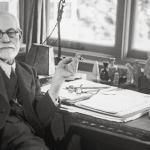James Simpson briefly reviews the career of the 17th-century iconoclast William Dowsing in his history of iconoclasm, Under the Hammer. What motivated Dowsing, he argues, wasn’t an effort to prioritize the word over the image, but a quest for “jurisdictional clarity.”
With the triumph of Parliament, the complex jurisdictional space of medieval Britain was simplified: “A single jurisdiction (of a Puritan Parliament) replaces a triple, overlapping jurisdiction of monarch, Parliament, and clergy; and those new jurisdictional imperatives seek symbolic realization in physical shape of churches. The very notion of privileged places was targeted as objectionable by evangelicals, since spiritual charisma was now evenly distributed across all space. It was not concentrated in one place, in one Church, and in part of one church, such as an image, or beyond the chancel arch, more than in another place” (88). Iconoclasm expresses the new commitment to “placelessness.”
This is phenomenologically, and perhaps historically, mistaken. The spatial hierarchy of medieval Catholic churches was simple space, a single one-way movement from God to priest to people. At their best, what Protestants aimed for was liturgical space that represented the complexity and mutuality of a body.
Simpson is on firmer ground when he argues that iconoclasm is driven by exhaustion and a history of failure. No effort to eradicate idols works, because, as Calvin says, the human heart is an idol factory. Iconoclasm is a grim and humorless business; there’s no way to win, and yet it must continue.
This ever-frustrated hunt for idols is built into some versions of Protestantism. Simpson puts it in extreme terms, but he’s on to something: “Protestant historiography asserts the existence of a true, though invisible church. The function, the entire function, of the visible, material church is hypocritically to disguise the existence of the True Church. This historiographical scheme has a visual concomitant: it alerts the eye to permanent distrust, and it prompts the hand to sudden motions of tearing, stripping, and breaking. The job, though, never can be done. Both iconoclasm and idolatry are on the lookout for another hit. Neither can ever be single acts; iconoclasm is, instead, a dynamic process, precisely because the iconoclast thinks idolatry is an addictive habit, impossible to kick” (93).
John Milbank cites evidence like to back up his claim that the Reformation isn’t really a reform, since it despairs of the possibility of successfully re-shaping the church in line with the gospel. It’s a movement that arises from the exhaustion of reform. That’s too extreme too, but it’s accurate enough to sting.












